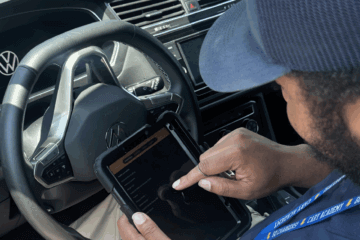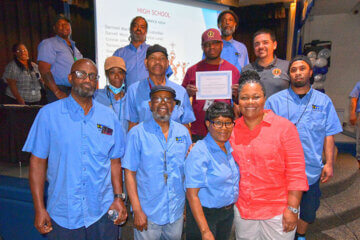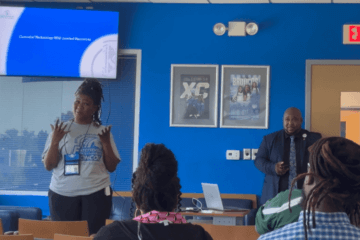The Office of Classroom at the University of Minnesota’s Twin Cities campus is focused on one thing: Making sure classrooms and informal learning spaces are ready for learning.
They want everything to be all set when students and faculty come in. That means markers ready to write on the cleared-off whiteboard, presentation equipment working smoothly, and no flickering lights or strange noises to distract students.
Because just one problem can distract students or force the instructor to stop class, the team decided it needed to check every space daily.
But with 349 classrooms and more than 38,000 square feet of informal study spaces, it’s a tall order. So how do they get it done?
The OCM employs dozens of student employees. These employees use mobile inspection software to make the rounds around campus each day. They inspect each space, make minor corrections, and communicate with the Facilities team about bigger issues. The data they collect helps the staff stay on top of recurring problems or trends.
The team shared their story and strategy at the 2019 MAPPA conference. We sat in on the talk and are excited to share their story here. (For the full backstory on how the OCM came to be, check out How the UMN Office of Classroom Management Skyrocketed Classroom Readiness from 41% to 95%.)
“Our vision is to support teaching and learning excellence by providing and managing high-quality learning environments,” says Jessica McCarty, a project manager with OCM.
The value of student employees at UMN
When the OCM started the classroom condition monitor program in 2002, “it was just two students with pen and paper, and then the one employee supervising them,” says Nick. “They were just sweeping across campus, getting to as many rooms as possible.”
Today, the program involves more than a dozen student employees — and as classrooms have changed and the OCM has grown, they’ve developed new programs, too.
For example, OCM was relying heavily on another department to solve technology problems in the classroom, which are hugely disruptive for instructors. So they created a role for student classroom technology monitors go out with a laptop and plug into all the connections in the presentation system to test it. The students themselves handle simple fixes. However, they also escalate bigger problems quickly, so that class isn’t disrupted.
The classroom condition and technology monitors are “reviewing for maintenance needs, custodial needs, operational needs,” Jessica says. “They’re doing a review of the AV equipment for repair needs, verifying features as well as reporting deficiencies.They’re communicating information concerning situations that need immediate escalation to full-time staff. They’re also coordinating their own workload with their coworkers.”
“In addition to that, they help us maintain classroom features and equipment,” says Jessica. “This includes moving and/or arranging furniture to the layout that it’s supposed to be. They’re checking and providing supplies, including batteries for microphones, chalk, markers, erasers, equipment like that. And they’re also actually repairing and managing our inventory.”
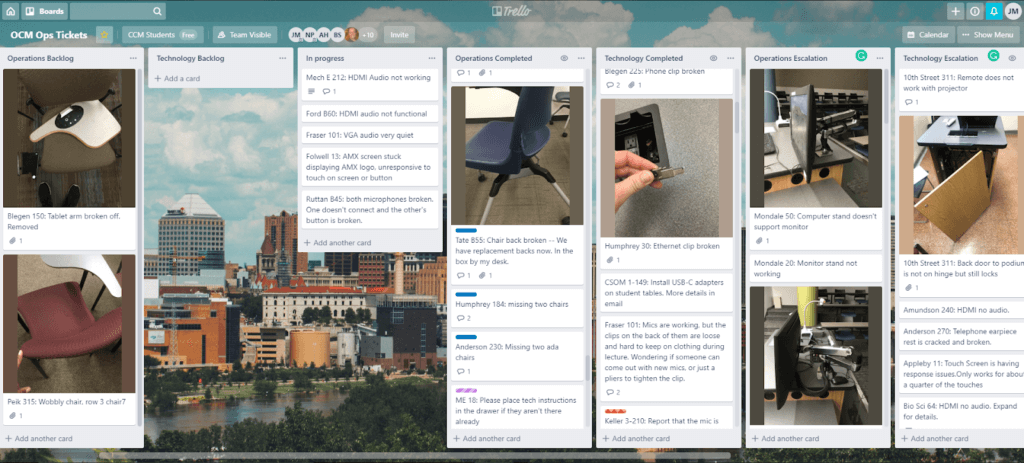
Classroom condition monitors also help out with occasional extra duties. These include preventative maintenance inspections, special audits, and warehouse activities like delivering furniture around campus.
Additionally, some students work at the office’s front desk, answering questions and handling scheduling for the spaces.
A day in the life of a classroom condition monitor
The monitors start their two-hour shifts at 6:30 a.m., which gives custodians a head start to take care of things before the students begin reporting issues.
“We have student stations on each of those locations so they can start out in the morning and leave right from their location and get to class . . . We try to make it easy for them so they can get off on the right foot and get to their classes.”
“This is a map that we use to give to our students when they’re training, and it gives you an idea of the amount of space and how spread out our campus is . . . They’re timed out so that each route is about 20 to 30 classrooms, and it should take the student about 2 hours just to get those done.”
“We want our students to spend about 4 to 5 minutes in the classrooms, really getting a good idea of what’s going on; don’t just open the door. Walk through it.”
Students are assigned a route of classrooms to inspect based on their own location. (Because the campus has three locations — East Bank, West Bank, and St. Paul — it makes sense for students to work near where they live and study.)
The monitors use iPads loaded with OrangeQC’s mobile inspection app. Jessica says that the inspection form walks students through everything they need to do, which streamlines the process for students.
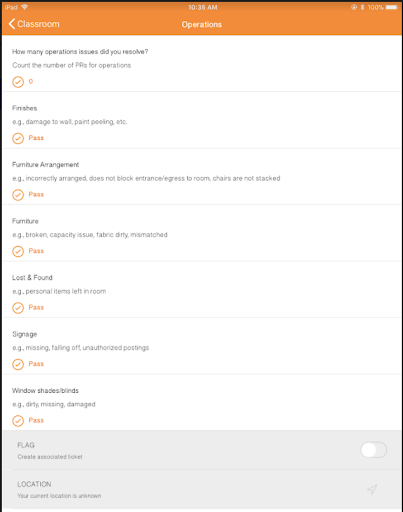
“It walks them through, what location are you at — East Bank, West Bank, St. Paul? What building are you in?” says Jessica. “It lists out the room number so they don’t have to remember each and every room number they’re supposed to check.”
The students indicate whether the classroom is empty and able to be inspected, or in use because class has started.
If the classroom is empty, the monitors use the classroom inspection form, which is broken into different categories for ease of reporting: operations, custodial, maintenance, and technology. (Technology monitors use a different form with more detail on technology.)
“We do track at the top there how many issues they do resolve while they’re in the room,” Jessica says. “So, just for example, in operations, a couple of those subcategories: Is the furniture arranged? Are there any issues with the signage we’ve placed in the room? Are there lost and found items?”
Line items from the custodial section include whether there is trash around the room and if the writing surface is ready. Maintenance issues might include things like an issue with the clock, door hardware, or something a tradesperson would have to resolve.
“It gives them some examples of what to look for, and then if they are reporting a deficiency, they just move that pass to fail,” Jessica says. “They open it up, they leave a quick comment on what the issue is, and it also allows them to take pictures right in that form for us to see.”
Jessica says that switching from pen-and-paper to OrangeQC mobile inspection software “gave us much more usable data, because everybody’s submitting it in the same form.”
“Because we were able to make it faster, get to more places, have an easier way to develop these reports, moving over to this iPad software overall helped us to improve classroom conditions over time because we have much more of a presence in our spaces on a daily basis,” she says.
Leadership positions for student employees
As the value of student employees became clear, the OCM created the lead position. Jessica says it “gave the way to show growth within our program and gave them the chance to take ownership within the job.”
Some student leads are “out with their backpack full of hammers . . . they’re actually fixing this furniture.” Then, there is a student who schedules the routes for the other students.
Student leads are also in charge of updating the team’s visual resources. “These are our 20-30 pictures of each and every classroom we have on campus,” Jessica says. “Any time something changes, they update it, so a supervisor or full-time staff member can look at these pictures and it’s as if they’re in that room without having to travel to that room”
Student leads also do preventative maintenance checks, update the inventory database, and mentor the other classroom condition monitors.
What to expect when managing students
If your team is looking into managing students, what should you expect? Jessica and Nick shared some of their perspective at MAPPA.
“It really is an entirely different game than supervising full-time employees,” says Jessica. “One of the best parts of it is seeing their creativity. You’re hiring students from all different perspectives, backgrounds, and majors, so they truly do — in addition to having different backgrounds to each other — have a very different perspective on what they want in a classroom as opposed to the usual higher-ed full-time staff.”
“For example, you might have an engineering student who gets promoted to the lead position really fast because they really have an eye for how to fix that furniture and get us back up to capacity,” she continues. “Or you might have a design student who looks at those visual resources and thinks of an entirely new way to take them that’s more visually appealing to the people looking at it. It’s amazing to see their creativity and ability to solve these problems.”
The students are also in a sweet spot for gaining new skills.
“They also exhibit a unique eagerness to learn and understand. They’re on campus, they’re in college, they’re in classes, they’re already trying to learn there and often, that gets applied to the workplace as well.”
Of course, challenges come with managing students versus full-time employees. Jessica points out that for many students, this is their first job beyond babysitting. They’re still learning how to be an employee.
Additionally, the turnover rate is high (which is why fine-tuning training methods has been so useful). Students graduate, their schedules change, or they find they’re swamped with schoolwork. It comes with the territory.
The student leadership positions within the OCM are helpful, but they also tap into a trend that Jessica noticed popping up for students.
“They’re more so looking for internships and jobs directly applicable to whatever major they’re in,” says Jessica. “It’s getting harder to find students who are just looking for that manual labor position just to get a job and work their way through college.”
Thanks so much to Jessica McCarty and Nick Pnewski for sharing the OCM’s success story and insight! We hope their experiences help other university teams considering integrating students into their process. For more insight, read on to learn how the OCM trains student employees for success.
Interested in how OrangeQC might work on your campus? Schedule a one-on-one demo for a low-pressure call where we’ll show you the features you want to see.

